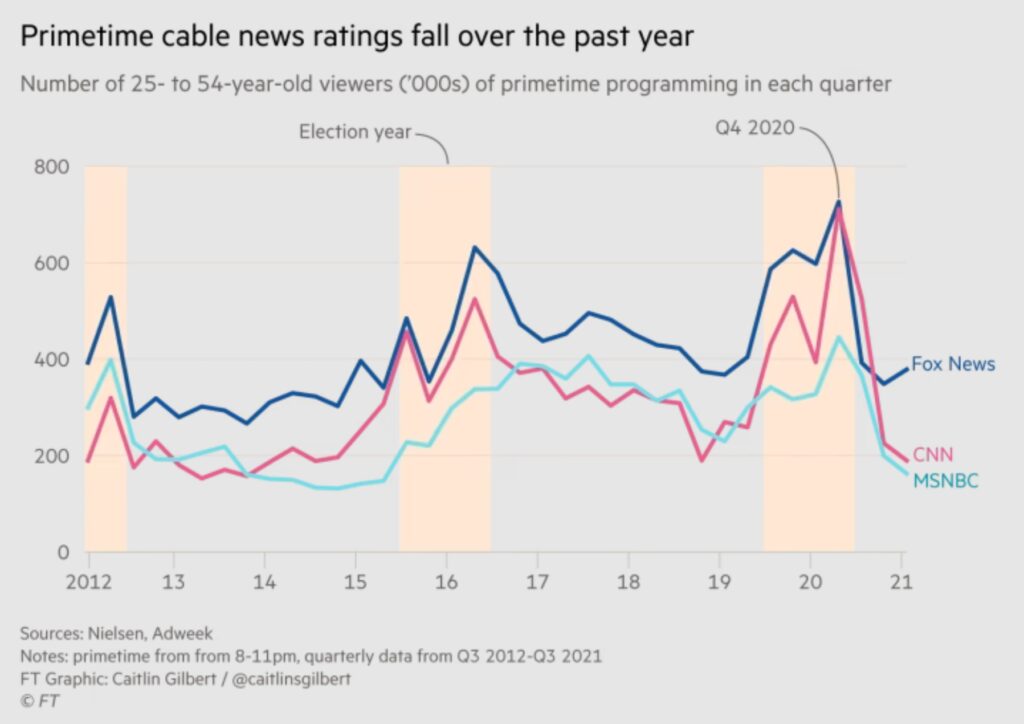Why the Public Has Lost Faith in CNN’s Credibility
In recent years, the once-revered news network CNN has faced a significant erosion of ratings, and a loss of trust and credibility among the general public. What was once regarded as a reliable source of information has now been clouded by skepticism and doubt. This article delves into the various factors that have contributed to the public’s loss of faith in CNN. From biased reporting and a perceived political agenda to a lack of objectivity and fact-checking, we explore the reasons behind this decline and analyze how CNN’s practices have impacted its reputation. Additionally, we examine the role of sensationalism, mistakes and retractions, selective coverage, and the spread of fake news in shaping public perception. Finally, we highlight the emergence of alternative media and its role in the shifting landscape of public trust in news outlets.

The historical significance of CNN
CNN, short for the Cable News Network, holds a significant place in the history of television news. In the early 1980s, it pioneered the concept of 24-hour news coverage, revolutionizing the way people consumed news. With its extensive reach and global presence, CNN became a household name, synonymous with reliable journalism.
Emerging concerns and skepticism
However, in recent years, concerns and skepticism regarding CNN’s credibility have started to emerge. A growing number of people, including viewers and critics alike, have begun to question whether CNN is truly delivering unbiased news or if it has succumbed to a political agenda.
CNN Biased Reporting and Leftist Political Agenda
One of the primary reasons behind the public’s loss of faith in CNN is its perceived alignment with leftist political ideology. CNN has often been the subject of allegations of party bias. The New York Times has described its development of a partisan lean during the tenure of Jeff Zucker. In independant research conducted by the Shorenstein Center on Media, Politics and Public Policy at Harvard University with the the Project for Excellence in Journalism, the authors found disparate treatment in CNN reporting of Republican and Democratic candidates during the earliest five months of the presidential primaries in 2007
A 2019 Pew Research survey showed that among Americans who named CNN as their main source for political and election news, 79% identify as Democrats whereas 17% identify as Republicans.Many critics argue that the network demonstrates a bias in favor of liberal viewpoints and often neglects to provide fair coverage of conservative perspectives. Such alignment can undermine the credibility of a news organization, as it raises doubts about the objectivity of their reporting.
Examples of CNN biased reporting
- Donna Brazile and Roland Martin – In October 2016, WikiLeaks published emails from John Podesta which showed CNN contributor Donna Brazile passing the questions for a CNN-sponsored debate to the Clinton campaign.
- Joe Rogan and Ivermectin – Rogan criticized CNN coverage for describing the medicine ivermectin as a “horse dewormer”. CNN Chief Medical Correspondent Sanjay Gupta later admitted during an interview that “[CNN] shouldn’t have said that”.
- Russia collusion – On January 10, 2017, CNN reported on the existence of classified documents that said Russia had compromising personal and financial information about then President-elect Donald Trump. The dossier had been read widely by political and media figures in Washington, and had been sent to multiple other journalists who had declined to publish it as it was unsubstantiated.
- Hunter Biden laptop – CNN spent months downplaying and dismissing the relevancy of Hunter Biden’s infamous laptop, which has since been confirmed as authentic by the Washington Post and New York Times.
- Nick Sandmann – On March 12, 2019, lawyers of Nick Sandmann, who was involved in the January 2019 Lincoln Memorial confrontation, filed a lawsuit on his behalf against CNN, seeking US$275 million in damages,for allegedly “vicious” and “direct attacks” towards Sandmann. CNN portrayed the incident with Sandmann as being racially charged before additional footage proved that a group of Black Hebrew Israelites had provoked the confrontation by slinging racial slurs at the students.
Instances of biased reporting have only fueled the skepticism surrounding CNN. The network has been accused of selectively highlighting information that supports their preferred narrative while downplaying or omitting facts that may challenge it. Whether it’s through the framing of stories or the choice of guests, some viewers feel that CNN’s reporting is more focused on pushing a specific agenda than on providing an unbiased account of events.
Lack of Objectivity and Fact-Checking
Journalistic objectivity is a fundamental tenet of responsible reporting. It requires journalists to present information impartially, free from personal biases or external influences. However, critics argue that CNN has failed to maintain this objectivity, resulting in a loss of trust from the public.
Inaccurate reporting and failure to fact-check
CNN has faced criticism for several instances of inaccurate reporting and failure to adequately fact-check their stories. When errors occur, it not only damages the credibility of the network but also raises questions about the integrity of their reporting processes. In an era where misinformation spreads rapidly, the failure to verify facts can have far-reaching consequences and further erode trust in the network’s reliability.
Sensationalism and Clickbait Journalism
The impact of sensationalism on news credibility
Sensationalism, the prioritization of eye-catching or shocking stories over substance, has become a prevalent tactic in modern news media. Some critics argue that CNN has succumbed to this trend, prioritizing sensational headlines and stories to attract viewers. While this may result in short-term gains in ratings, it can significantly undermine the credibility of a news organization in the long run.
Clickbait tactics and their effect on public trust
In an effort to increase online engagement, CNN, like many other media outlets, has employed echo chambers and clickbait tactics. These tactics involve crafting misleading or exaggerated headlines to entice readers to click on articles and feeding inforation to like minded recipients. While these tactics may generate more website traffic, they contributes to the erosion of public trust in news organizations, as viewers feel manipulated and deceived.
CNN’s decline in credibility can be attributed to concerns over biased reporting and the perception of a political agenda, as well as a lack of objectivity and fact-checking. Furthermore, the adoption of sensationalism and clickbait tactics has further damaged public trust. To regain credibility, CNN and other news organizations must prioritize unbiased reporting, journalistic integrity, and a commitment to factual accuracy.
CNN Mistakes, Retractions, and Lack of Accountability
Prominent mistakes and misleading reporting
CNN, once regarded as a beacon of reliable news, has experienced its fair share of embarrassing mistakes and misleading reporting. From falsely identifying suspects in high-profile cases to misrepresenting facts, the network has stumbled on numerous occasions. These mistakes not only undermine their credibility but also erode public trust in their ability to deliver accurate news.
The absence of accountability and its consequences
One of the most frustrating aspects of the news network’s missteps is the lack of accountability. While retractions and corrections are made, they often receive far less attention than the original false reporting. This lack of accountability sends a message that mistakes can be made without consequence. As a result, the public becomes skeptical of the network’s commitment to accuracy and begins to question whether there could be more instances of misleading information that go unaddressed.
Selective Coverage and Narrative-Shaping
Cherry-picking stories and omitting crucial information
CNN has faced criticism for selectively covering stories that align with their desired narratives. By cherry-picking certain events to highlight and downplaying or omitting others, they shape the narrative in a way that can be misleading. This selective coverage can lead to an incomplete understanding of events and leave viewers questioning the network’s objectivity and integrity.
The influence of narrative-shaping on public perception
When a news outlet consistently shapes the narrative to fit a particular agenda, it can significantly impact public perception. By presenting a one-sided view of events, they risks alienating viewers who seek a balanced approach to news reporting. As a result, trust in the network diminishes, and the public becomes more inclined to question the motives behind their storytelling.
CNN’s Role in the Spread of Fake News
Contributing to the proliferation of fake news
While CNN prides itself on being a trustworthy news source, it cannot escape its role in the spread of fake news. Whether through hasty reporting or failure to fact-check, the network has been instrumental in disseminating misleading information. This contribution to the proliferation of fake news further undermines their credibility and reinforces public skepticism.
The impact on credibility and public confidence
The consequences of CNN’s involvement in spreading fake news are far-reaching. As public trust in traditional news outlets erodes, individuals turn to alternative sources for information. CNN’s credibility takes a hit, and the public becomes wary of accepting their reports at face value. Restoring this lost confidence becomes a monumental task for the network.
Alternative Media and the Shift in Public Trust
The rise of alternative media sources
With the decline in trust towards mainstream news outlets, alternative media sources have gained popularity. These platforms, often with a more grassroots and independent approach to news, offer an alternative perspective and cater to audiences seeking a fresh take. The rise of alternative media has further diminished the influence and reliance on CNN and other similar networks.
Changing dynamics of public trust in news outlets
The public’s trust in news outlets has undergone a significant shift in recent years. With the advent of social media and the widespread availability of information, people now have more options to verify news and fact-check claims. This changing landscape has made it essential for news organizations to adapt, be transparent, and regain trust through accurate reporting and accountability.
CNN’s loss of public faith can be attributed to a combination of mistakes, lack of accountability, selective coverage, and its role in the spread of fake news. The rise of alternative media has further challenged the traditional authority of news outlets, making it imperative for CNN and others to reassess their approach and rebuild trust with the public.
The loss of faith in CNN by the public is not a result of a single factor but rather a culmination of various issues. Biased reporting, lack of objectivity, sensationalism, and the spread of fake news have all played a role in eroding the news network’s credibility. As the public becomes more aware and discerning, alternative media sources are gaining traction, offering different perspectives and challenging the mainstream narrative. CNN and other news outlets must address these concerns, regain trust through transparency and accountability, and strive to prioritize unbiased reporting and journalistic integrity. Only then can they hope to restore the faith of an increasingly skeptical public.





